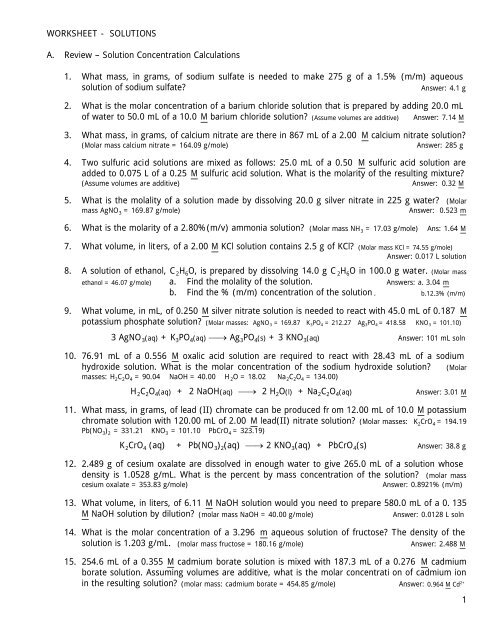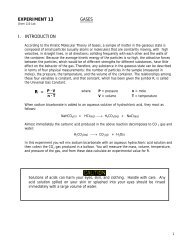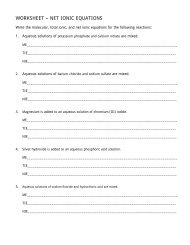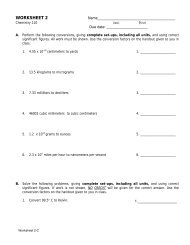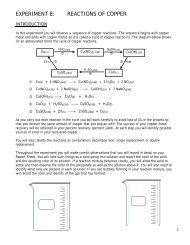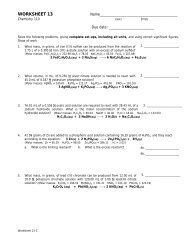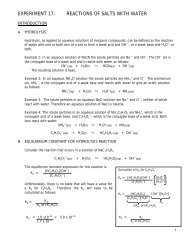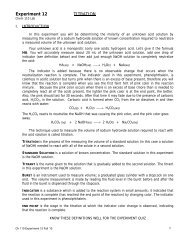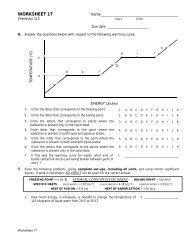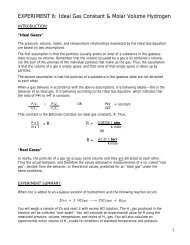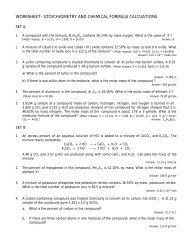WORKSHEET - SOLUTIONS A. Review â Solution ... - Ccchemistry.us
WORKSHEET - SOLUTIONS A. Review â Solution ... - Ccchemistry.us
WORKSHEET - SOLUTIONS A. Review â Solution ... - Ccchemistry.us
You also want an ePaper? Increase the reach of your titles
YUMPU automatically turns print PDFs into web optimized ePapers that Google loves.
<strong>WORKSHEET</strong> - <strong>SOLUTIONS</strong><br />
A. <strong>Review</strong> – <strong>Solution</strong> Concentration Calculations<br />
1. What mass, in grams, of sodium sulfate is needed to make 275 g of a 1.5% (m/m) aqueo<strong>us</strong><br />
solution of sodium sulfate?<br />
Answer: 4.1 g<br />
2. What is the molar concentration of a barium chloride solution that is prepared by adding 20.0 mL<br />
of water to 50.0 mL of a 10.0 M barium chloride solution? (Assume volumes are additive) Answer: 7.14 M<br />
3. What mass, in grams, of calcium nitrate are there in 867 mL of a 2.00 M calcium nitrate solution?<br />
(Molar mass calcium nitrate = 164.09 g/mole)<br />
Answer: 285 g<br />
4. Two sulfuric acid solutions are mixed as follows: 25.0 mL of a 0.50 M sulfuric acid solution are<br />
added to 0.075 L of a 0.25 M sulfuric acid solution. What is the molarity of the resulting mixture?<br />
(Assume volumes are additive) Answer: 0.32 M<br />
5. What is the molality of a solution made by dissolving 20.0 g silver nitrate in 225 g water? (Molar<br />
mass AgNO 3 = 169.87 g/mole)<br />
Answer: 0.523 m<br />
6. What is the molarity of a 2.80%(m/v) ammonia solution? (Molar mass NH 3 = 17.03 g/mole) Ans: 1.64 M<br />
7. What volume, in liters, of a 2.00 M KCl solution contains 2.5 g of KCl? (Molar mass KCl = 74.55 g/mole)<br />
Answer: 0.017 L solution<br />
8. A solution of ethanol, C 2 H 6 O, is prepared by dissolving 14.0 g C 2 H 6 O in 100.0 g water. (Molar mass<br />
ethanol = 46.07 g/mole) a. Find the molality of the solution. Answers: a. 3.04 m<br />
b. Find the % (m/m) concentration of the solution . b.12.3% (m/m)<br />
9. What volume, in mL, of 0.250 M silver nitrate solution is needed to react with 45.0 mL of 0.187 M<br />
potassium phosphate solution? (Molar masses: AgNO 3 = 169.87 K 3 PO 4 = 212.27 Ag 3 PO 4 = 418.58 KNO 3 = 101.10)<br />
3 AgNO 3 (aq) + K 3 PO 4 (aq) Ag 3 PO 4 (s) + 3 KNO 3 (aq) Answer: 101 mL soln<br />
10. 76.91 mL of a 0.556 M oxalic acid solution are required to react with 28.43 mL of a sodium<br />
hydroxide solution. What is the molar concentration of the sodium hydroxide solution?<br />
masses: H 2 C 2 O 4 = 90.04 NaOH = 40.00 H 2 O = 18.02 Na 2 C 2 O 4 = 134.00)<br />
(Molar<br />
H 2 C 2 O 4 (aq) + 2 NaOH(aq) 2 H 2 O(l) + Na 2 C 2 O 4 (aq) Answer: 3.01 M<br />
11. What mass, in grams, of lead (II) chromate can be produced fr om 12.00 mL of 10.0 M potassium<br />
chromate solution with 120.00 mL of 2.00 M lead(II) nitrate solution? (Molar masses: K 2 CrO 4 = 194.19<br />
Pb(NO 3 ) 2 = 331.21 KNO 3 = 101.10 PbCrO 4 = 323.19)<br />
K 2 CrO 4 (aq) + Pb(NO 3 ) 2 (aq) 2 KNO 3 (aq) + PbCrO 4 (s) Answer: 38.8 g<br />
12. 2.489 g of cesium oxalate are dissolved in enough water to give 265.0 mL of a solution whose<br />
density is 1.0528 g/mL. What is the percent by mass concentration of the solution?<br />
cesium oxalate = 353.83 g/mole)<br />
(molar mass<br />
Answer: 0.8921% (m/m)<br />
13. What volume, in liters, of 6.11 M NaOH solution would you need to prepare 580.0 mL of a 0. 135<br />
M NaOH solution by dilution? (molar mass NaOH = 40.00 g/mole)<br />
Answer: 0.0128 L soln<br />
14. What is the molar concentration of a 3.296 m aqueo<strong>us</strong> solution of fructose? The density of the<br />
solution is 1.203 g/mL. (molar mass fructose = 180.16 g/mole)<br />
Answer: 2.488 M<br />
15. 254.6 mL of a 0.355 M cadmium borate solution is mixed with 187.3 mL of a 0.276 M cadmium<br />
borate solution. Assuming volumes are additive, what is the molar concentrati on of cadmium ion<br />
in the resulting solution? (molar mass: cadmium borate = 454.85 g/mole) Answer: 0.964 M Cd 2+<br />
1
B. New<br />
16. The density of a 60.00 % (m/m) ethanol, C 2 H 5 OH, solution is 0.8937 g/mL. What is the molarity<br />
of the solution? (molar mass = 46.07 g/mole)<br />
Answer: 11.64 M<br />
17. The density of a 2.687 M sodium acetate solution is 1.104 g/mL. What is the concentration of<br />
this solution expressed as % (m/m) NaC 2 H 3 O 2 ? (molar mass = 82.03 g/mole) Answer: 19.97 % (m/m)<br />
18. An aqueo<strong>us</strong> solution of citric acid, H 3 C 6 H 5 O 7 , is 0.655 M and has a density of 1.049 g/mL. What<br />
is the molality of the solution? (molar mass = 192.13 g/mole) Answer: 0.710 m<br />
19. An aqueo<strong>us</strong> solution of tartaric acid, H 2 C 4 H 4 O 6 , is 0.278 m and has a density of 1.006 g/mL.<br />
What is the molarity of the solution? (molar mass = 150.09 g/mole) Answer: 00.268 M<br />
20. Calculate the molality of a 23.0% by mass acetic acid, HC 2 H 3 O 2 , solution. (molar mass = 60.05<br />
g/mole)<br />
Answer: 4.97 M<br />
21. The concentration of a Pb(NO 3 ) 2 solution is 0.953 m and 0.907 M. What is the density of the<br />
solution, in grams per mL? (molar mass = 331.21 g/mole) Answer: 1.25 g/mL<br />
1. Find the molar concentration of each of the ions in a solution that contains 0.165 moles of<br />
aluminum chloride in 820 mL solution. Answers: 0.201 M Al 3+ , 0.603 M Cl -<br />
2. Find the molar concentration of each of the ions in a solution that results from mixing 27 mL of<br />
0.25 M HNO 3 with 36 mL of 0.42 M Ca(NO 3 ) 2 . (Assume volumes are additive.)<br />
Answers: 0.11 M H + , 0.59 M NO 3 - , 0.24 M Ca 2+<br />
3. Find the molarity of each of the ions present in a solution prepared by mixing 3 5 mL of 0.42 M<br />
K 2 SO 4 with 27 mL of 0.17 M K 3 PO 4 . (Assume volumes are additive.)<br />
Answers: 0.71 M K + , 0.24 M SO 4 2- , 0.074 M PO 4<br />
3-<br />
4. Calculate the molar concentration of each ion present in solution, and the mass of any solid<br />
remaining, after the reaction that occurs when of 0.300 mole of aluminum hydroxide is added to<br />
50.0 mL of 2.5 M nitric acid solution (Assume that there is no volume change upon the addition<br />
of the aluminum hydroxide to the solution). Hint: Write a balanced equation for the reaction<br />
taking place. Answers:, 0.83 M Al 3+ , 2.5 M NO 3 - , 20 g Al(OH) 3<br />
5. A solution consists of 3.88 g benzene, C 6 H 6 , and 2.45 g toluene ,C 7 H 8 . The vapor pressures of<br />
benzene and toluene at 20°C are 75 torr and 22 torr respectively. Assuming the solution behaves<br />
ideally, calculate the mole fraction of benzene in the vapor. (molar masses: C 6 H 6 = 78.0 g/mole; C 7 H 8 =<br />
92.0 g/mole.) A nswer= 0.87<br />
6. The freezing point of an aqueo<strong>us</strong> solution of glucose, C 6 H 12 O 6 , is ̵10.3°C. The density of the<br />
solution is 1.50 g/mL. What is the molarity of the glucose solution? (molar mass glucose = 180.0<br />
g/mole; K f for water is 1.86°C.kg/mole)<br />
A nswer: 4.16 M<br />
7. What is the normal boiling point of a 2.70 M aqueo<strong>us</strong> solution of KBr that has a density of 1.80<br />
g/mL? (K b for H 2 O is 0.512°C kg/mole)<br />
Answer: 101.9°C<br />
8. 28.00 mL of 0.670 M potassium carbonate solution is mixed with 15.00 mL of 0.940 M<br />
cobalt(III) chloride.<br />
a. Write the molecular, total and net ionic equations for the reaction that occurs.<br />
b. Identify any solid formed in the reaction and cal culate its mass.<br />
c. Calculate the molar concentration of each ion remaining in solution after the reaction is<br />
complete. Answers: b. 1.87 g of Co 2 (CO 3 ) 3 ; c. 0.874 M K + , 0.0372 M Co 3+ , 0.986 M Cl - 2-<br />
, 0 M CO 3<br />
2
1. A solution that contains 12.6 g of a solid nonvolatile nonelectrolyte dissolved in 400 g of benzene<br />
freezes at 3.6°C. The normal freezing point of benzene is 5.5°C. What is the molar mass of the<br />
solute? (K f for benzene is 4.96°C kg/mole) Answer: 82 g/mole<br />
2. Chloroform and methanol form an ideal solution. The solution boils at 22°C and 0.255 atm. At 22°C<br />
the vapor pressures of methanol and chloroform are 0.192 atm and 0.311 atm respectively. What is<br />
the mole fraction of chloroform in the solution? Answer: 0.529<br />
3. What is the normal boiling point of a 1.21 M aqueo<strong>us</strong> solution of calcium iodide that has a density of<br />
1.92 g/mL? (K b for H 2 O is 0.512°C kg/mole) Answer: 101.2°C<br />
4. Calculate the freezing point o f an aqueo<strong>us</strong> solution that is 36.0 % by mass Na 3 PO 4 .<br />
(K f for H2O = 1.86°C kg/mole) Answer: -25.5°C<br />
5. 32.00 mL of 0.311 M aluminum nitrate is mixed with 64.00 mL of 0.177 M sodium carbonate and<br />
allowed to react.<br />
a. Write the molecular, total and net ionic equations for the reaction that occurs.<br />
b. Identify and solid formed in the reaction and calculate its mass.<br />
c. Calculate the molar concentration of each ion remaining in solution after the reaction is<br />
complete. Answers: b. 0.884 g of Al 2 (CO 3 ) 3 c. 0 M CO 2- 3 , 0.0252 M Al 3+ , 0.312 M NO - 3 , 0.236 M Na +<br />
1. What is the molar concentration of an aqueo<strong>us</strong> solution of C 6 H 12 O 6 (a nonvolatile nonelectrolyte) that<br />
has a boiling point of 101.40°C and a density of 1.68 g/mL?<br />
(K b for H 2 O is 0.512°C kg/mole)<br />
Answer: 3.07 M<br />
2. What is the normal freezing point of a 0.6837 M aqueo<strong>us</strong> solution of C 12 H 22 O 11 (a nonvolatile<br />
nonelectrolyte), that has a density of 1.35 g/mL? (K f for H2O = 1.86°C kg/mole) Answer: 1.14°C<br />
3. Two volatile liquids, heptane, C 7 H 16 , and octane, C 8 H 18 , form an ideal solution. At 40°C the vapor<br />
pressure of pure heptane is 0.522 atm, and the vapor pressure of pure octane is 0.238 atm. A<br />
solution is prepared by mixing 5.32 g heptane and 8.80 g octane. Calculate the mole fraction of<br />
octane in the vapor above the solution. Answer: 0.398<br />
4. C 4 H 2 N is a nonvolatile molecular compound. When 3.84 g C 4 H 2 N is dissolved in 500 g benzene, the<br />
resulting solution has a freezing p oint that is 0.307°C lower than that of pure benzene. What are<br />
the molar mass and molecular formula of C 4 H 2 N?<br />
(K f for benzene = 5.12 °C kg/mole)<br />
Answers: 128 g/mole; C 8 H 4 N 2<br />
5. Liquids A and B form an ideal solution. The vapor pressure of pure A is 0.700 atm at the normal<br />
boiling point of a solution prepared from 0.250 mole of B and 0.650 mole of A. What is the vapor<br />
pressure of pure B at this temperature?<br />
Answer: 1.77 atm<br />
6. A 0.900 L aqueo<strong>us</strong> solution contains 30.0 g of a compound. The osmotic pressure of the solution is<br />
12.7 torr at 25°C. What is the molar mass of the compound? Answer: 4.88 x 10 4 g/mole<br />
7. Acetone and methanol form ideal solution. At 25°C, the vapor pressures of pure acetone and pure<br />
methanol are 0.342 atm and 0.188 atm respectively. Calculate the mole fraction of methanol in a<br />
solution that boils at 25°C and 0.248 atm. Answer: 0.610<br />
3


